Manchester City met Leicester City at the Etihad Stadium to continue their Premier League journey last weekend. The home side, unfortunately, had to host the Foxes with a depleted squad. Big names such as Bernardo Silva, İlkay Gündoğan, Gabriel Jesus, and Sergio Agüero were unavailable due to various reasons. Interestingly, Leicester didn’t come with a full squad either. Defensive midfielder Wilfred Ndidi joined Ricardo Pereira in the medical room after getting injured against Burnley in the previous weekend.
Such a situation, however, didn’t make the game less interesting. Seven goals, three penalties, and two world-class goals were the proof behind that. Unlucky for the Citizens, they had to admit Leicester’s superiority in a shocking 2–5 scoreline. How did that happen? This tactical analysis will try to dissect both teams’ tactics in the match.
Lineups
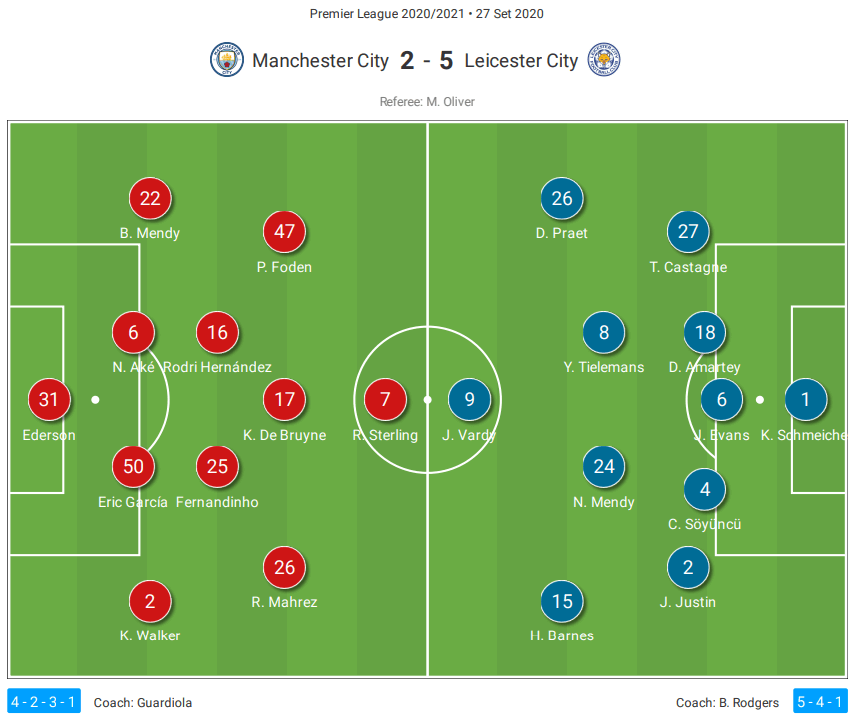
Pep Guardiola went for a 4–2–3–1 in this game as Ederson Moraes started between the sticks after getting some rest last midweek and was supported by the duo of Eric García and Nathan Aké in front of him. Up front, former Liverpool player Raheem Sterling led the attacking line with Riyad Mahrez, Kevin De Bruyne, and Phil Foden playing behind him. Names like Liam Delap and new recruit Ferran Torres had to start the game from the bench.
In the opposite side, Brendan Rodgers chose 5–4–1 for his squad. The trio of Daniel Amartey, Jonny Evans, and Çağlar Söyüncü started in the heart of Leicester’s defence. Talisman Jamie Vardy started alone in the firing line with only Harvey Barnes occasionally joining the attack from the midfield. The Foxes’ bench was filled with names like James Maddison, Kelechi Ịheanachọ, and Premier League-winner Christian Fuchs.
General ideas
This analysis will start by examining both teams’ general plans in their tactics. As the formations showed, Leicester seemed happy to concede possession and allow City to have the ball for most of the time. When they had the ball, City would shift into a 3–1–6/3–1–5–1-ish shape. The rotations were as follows:
One of the midfielders, namely Fernandinho, would drop to the right half-space and join the centre-backs. This movement made Aké, García, and Rodri move accordingly in City’s first two lines. In the flanks, both full-backs went forward to provide width while the wingers tucked inside to play in the respective half-spaces.
The most interesting feat in City’s system was De Bruyne’s role. The Belgian was given the freedom to move from across the pitch to combine with the flank players whenever needed. This role is crucial because City often played through the flanks, which we’ll discuss in the next section.

The Filberts, contrastingly, kept their 5–4–1 shape and defended very compactly. It meant that they would try to protect the central space and allow virtually no gap in between the lines. It wasn’t just that, though. Despite playing alone up front, Vardy was handed a specific task – to close Rodri whenever possible, and to prevent him from dictating City’s offensive plays.
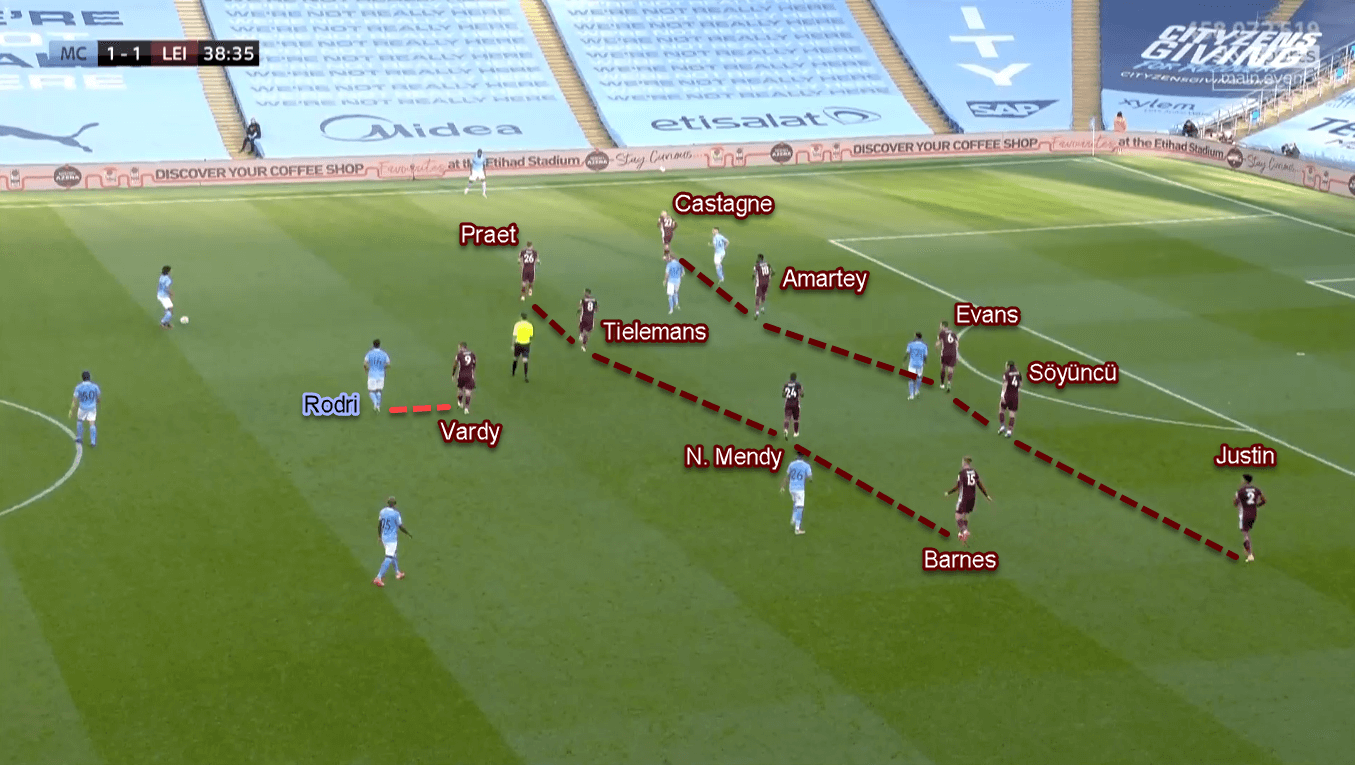
City’s various flank approach
The Citizens tried to attack through wide areas due to Leicester’s incredibly compact defensive block. In the process, they would utilise Kyle Walker and Benjamin Mendy in the flanks to create chances. There were two ways that City used to access both full-backs before continuing into the final third.
Firstly, by Fernandinho’s diagonal passes. As we know from before, Rodri was often closed tightly by Vardy in City’s second line of attacks. This enabled the centre-backs to bring the ball forward with more ease and distribute the ball to the flank. Fernandinho — playing as a makeshift centre-back — often moved forward inside the right half-space and exploit the numerical superiority. The Brazilian then could find rather free Ben Mendy in the opposite flank because Leicester’s defensive block has shifted a bit towards him.
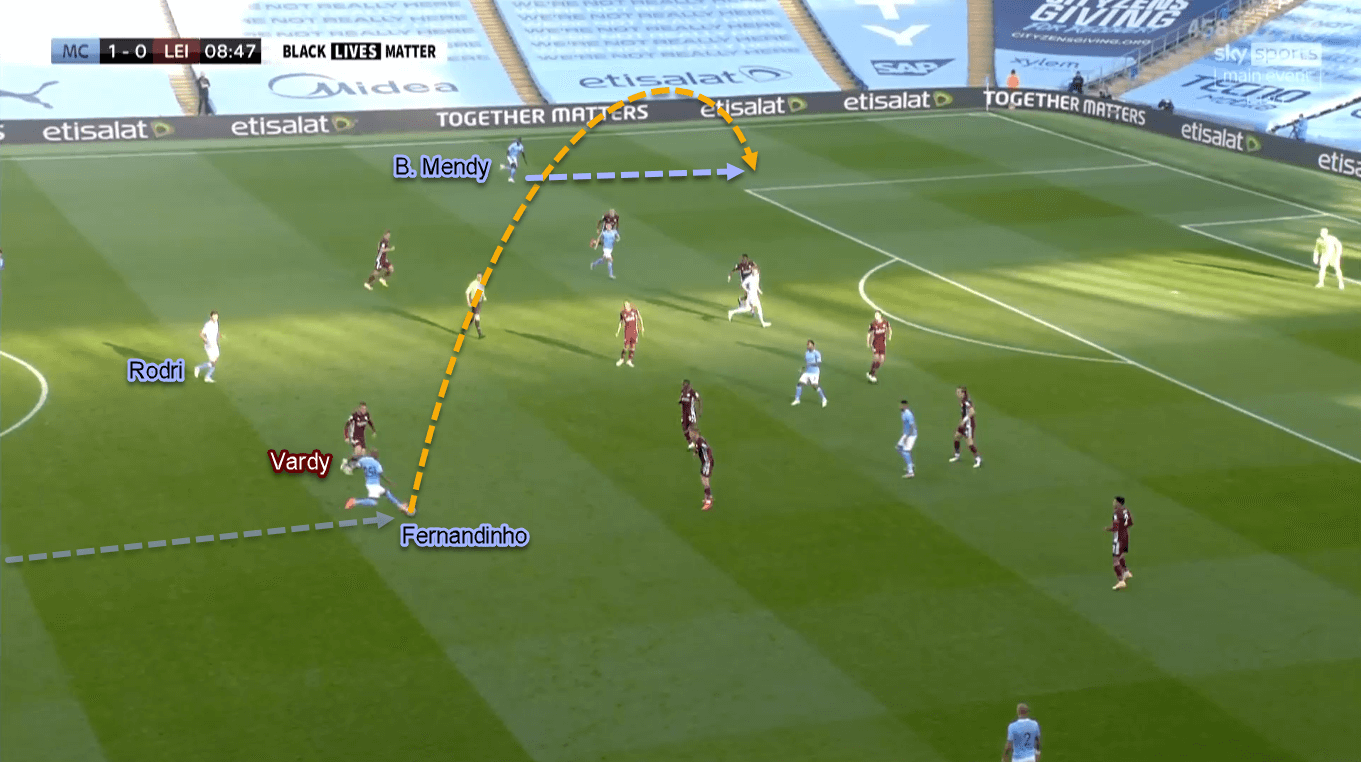
Secondly, City could access their full-backs rather conservatively. This means the outside centre-back would play ground-passes to his ball-side full-back: Fernandinho to Walker, and Aké to Ben Mendy. Sometimes García can provide the passes too due to his unmarked position behind Rodri. This rather simple approach was less risky and didn’t make City have to concede any gap in the right half-space.
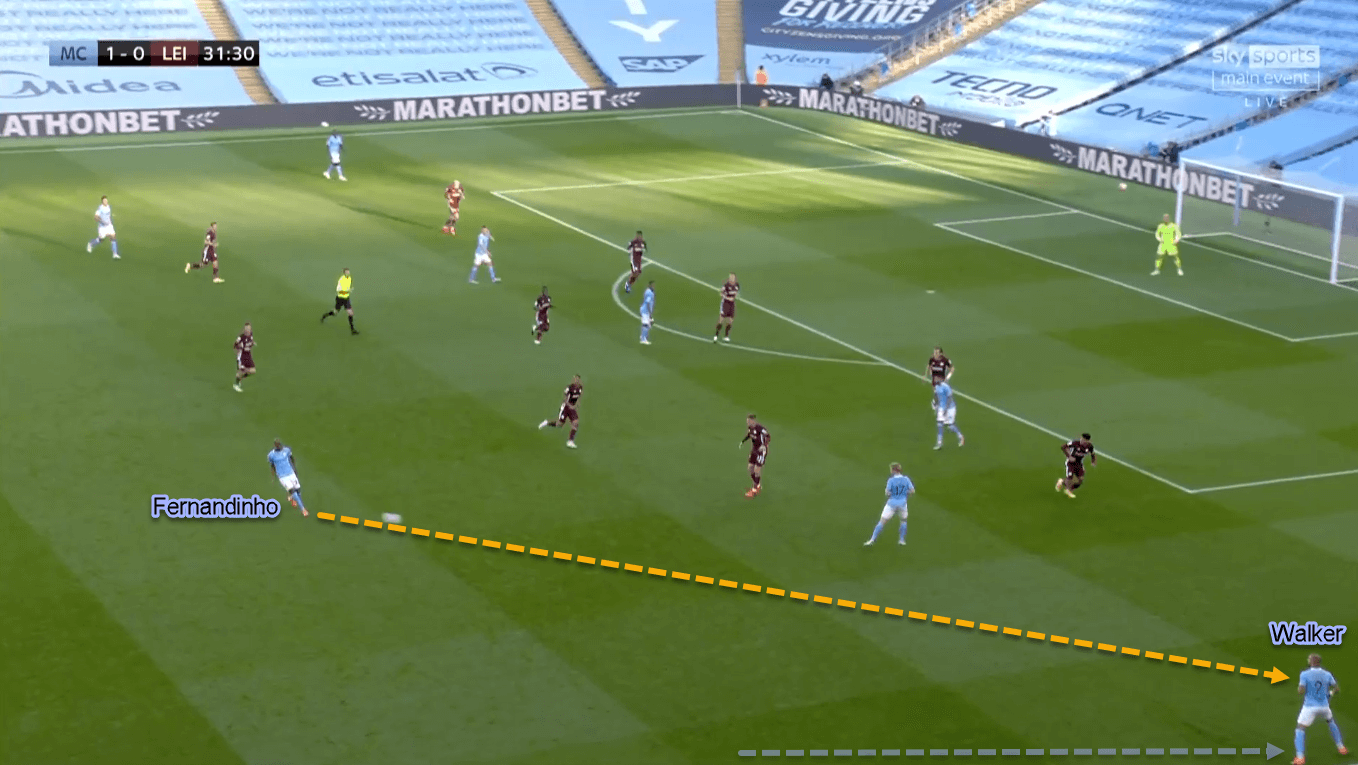
Blunt Blues
Coming into the final third, the men in sky blue had two options to continue their attack. The most simple way to do that was by allowing Walker and Mendy to quickly cross the ball into the box. Usually, they would use grounded or hard-and-low crosses to access the attackers, particularly before Delap came in. That’s because of the relatively small statures of Sterling and co. compared to Amartey, Evans, and Söyüncü.
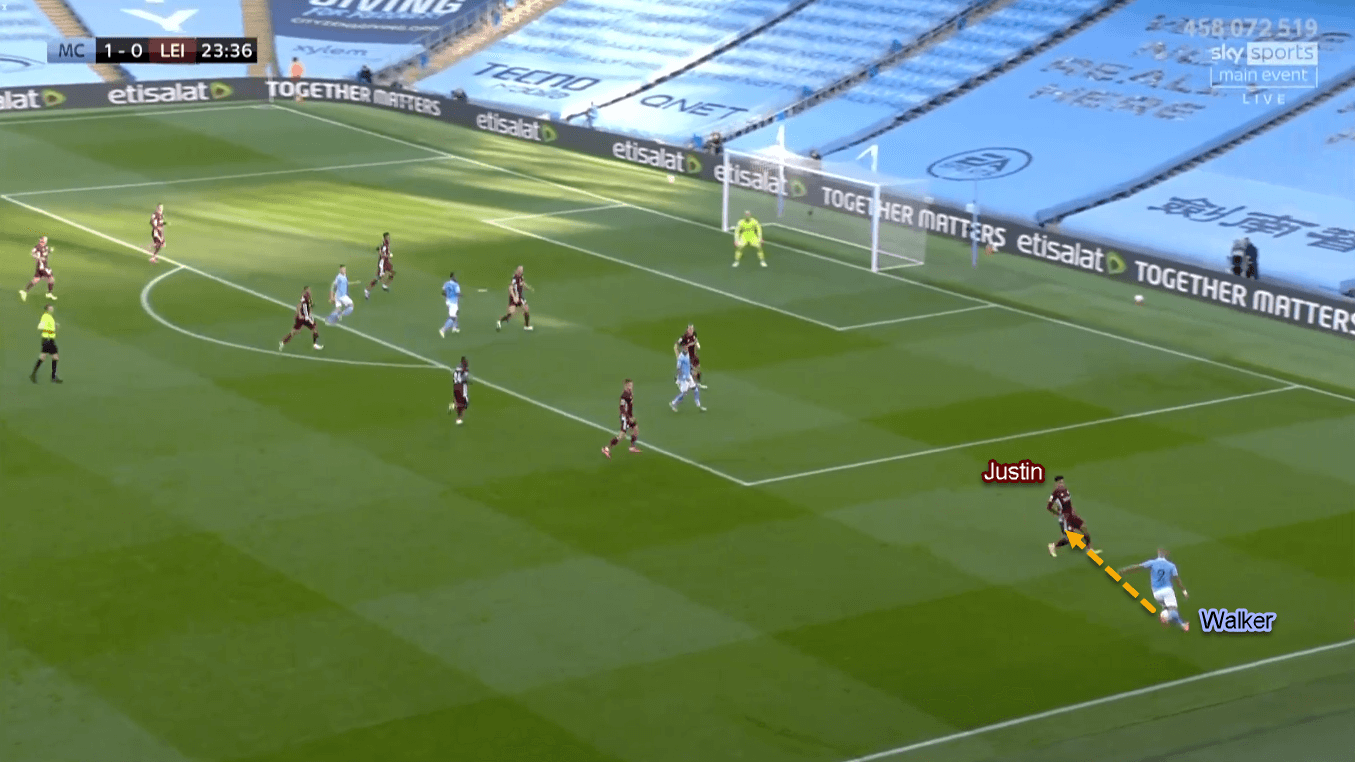
Another way they could send the crosses was by utilising De Bruyne in behind. As this analysis has mentioned before, the Belgian was given the freedom to roam from flank-to-flank and help the full-backs from the half-space. In the process, either Walker or Mendy would try to find De Bruyne in behind with an incisive diagonal pass to the byline. After that, the number 17 can send low-crosses for his attacking comrades in the box.
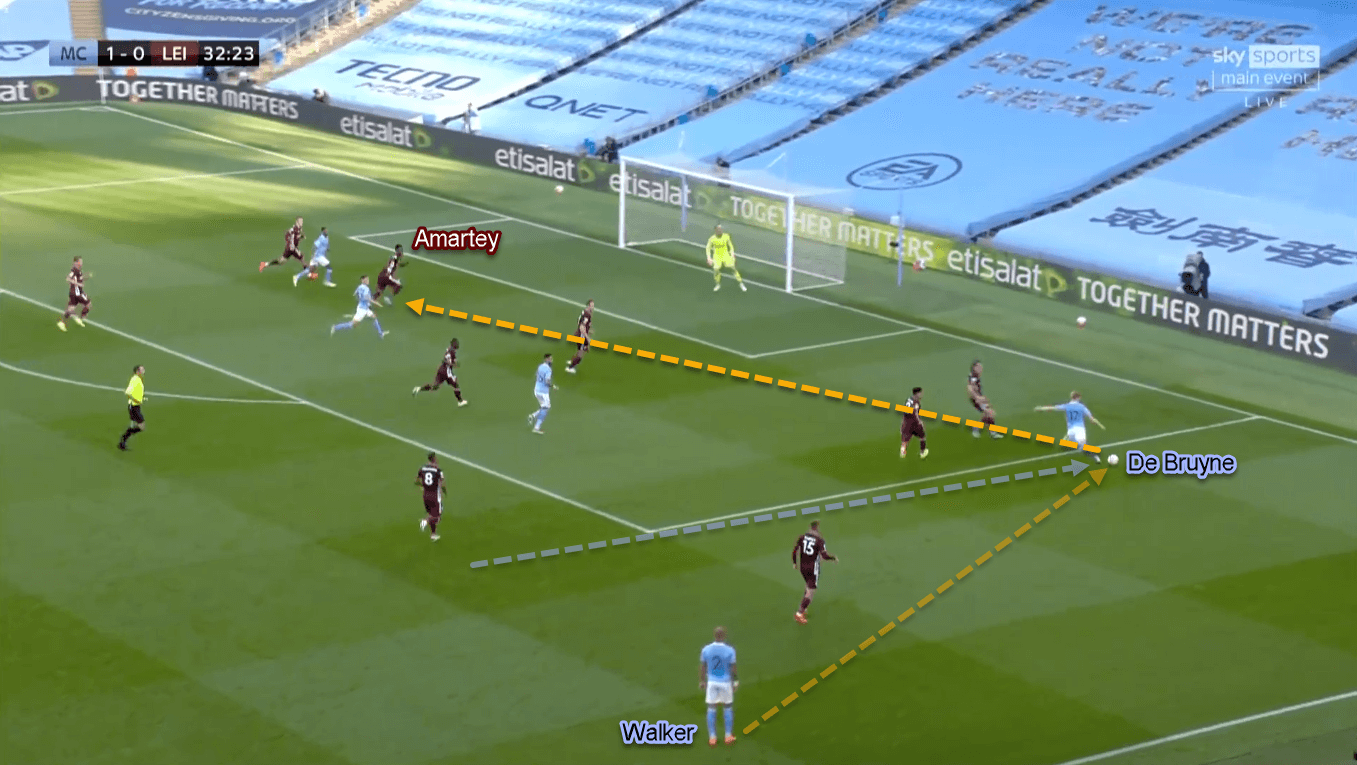
This approach was easily blunted by Leicester. That was mainly because of their calculated flank press, which will be examined after this. The stats showed that City only completed three (11.11%) crosses throughout the game. Ironically, De Bruyne was the worst contributor as he only made one (12.5%) successful cross from eight attempts.
Leicester defended the flank perfectly
The main reason behind City’s bluntness is Leicester’s well-calculated defence. Indeed, they focused on closing the central spaces in their compact 5–4–1 but they also protected the wide areas cleverly when the ball was there.
It was Leicester’s ball-side wing-back that was given the role to close Walker and Ben Mendy. In the process, either Timothy Castagne or Justin would step out from the backline and close City’s on-ball full-back immediately. The objective behind that was to prevent Walker and Ben Mendy to have much space and time with the ball. As a result, Castagne and Justin could block the crosses easily or force City to play backwards.
Another important feature could also be found inside. As we knew, Walker or Ben Mendy could combine with their teammate(s) in the half-space – either De Bruyne or the inside wingers. However, City couldn’t do that easily. This was because Leicester’s ball-side winger would drop and close the City player inside the half-space. Sometimes the winger’s role could also be supported by the ball-side centre-back, making City outnumbered and unable to continue their attack.
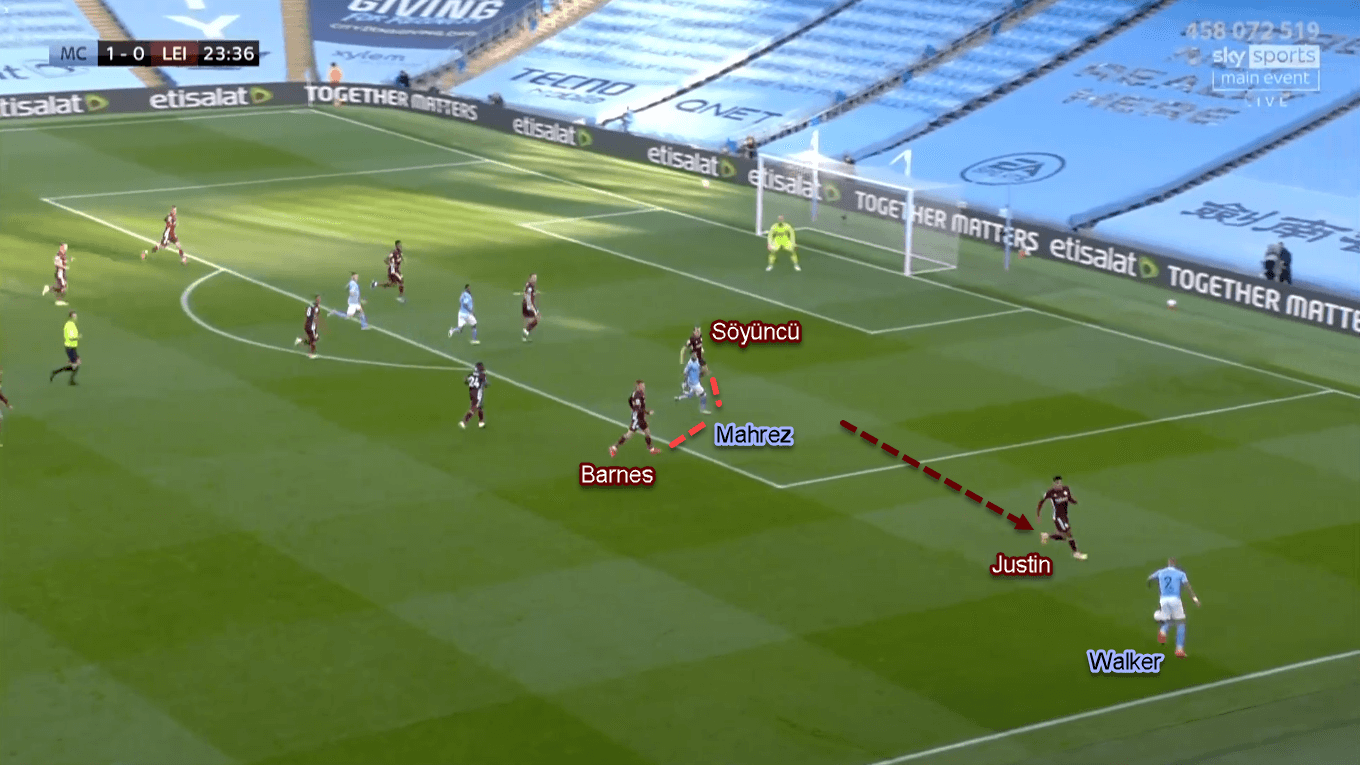
Another way Leicester could defend the flank was by using the ball-side winger. The City player in the half-space then would be closed by the drifting defensive midfielder and/or the ball-side wing-back: a numerical advantage for Leicester. This approach mostly happened when the home side were able to circulate the ball quickly and disorganise Leicester’s defence for some moments. However, this was rather an anomaly because of City’s slowness when moving the ball.
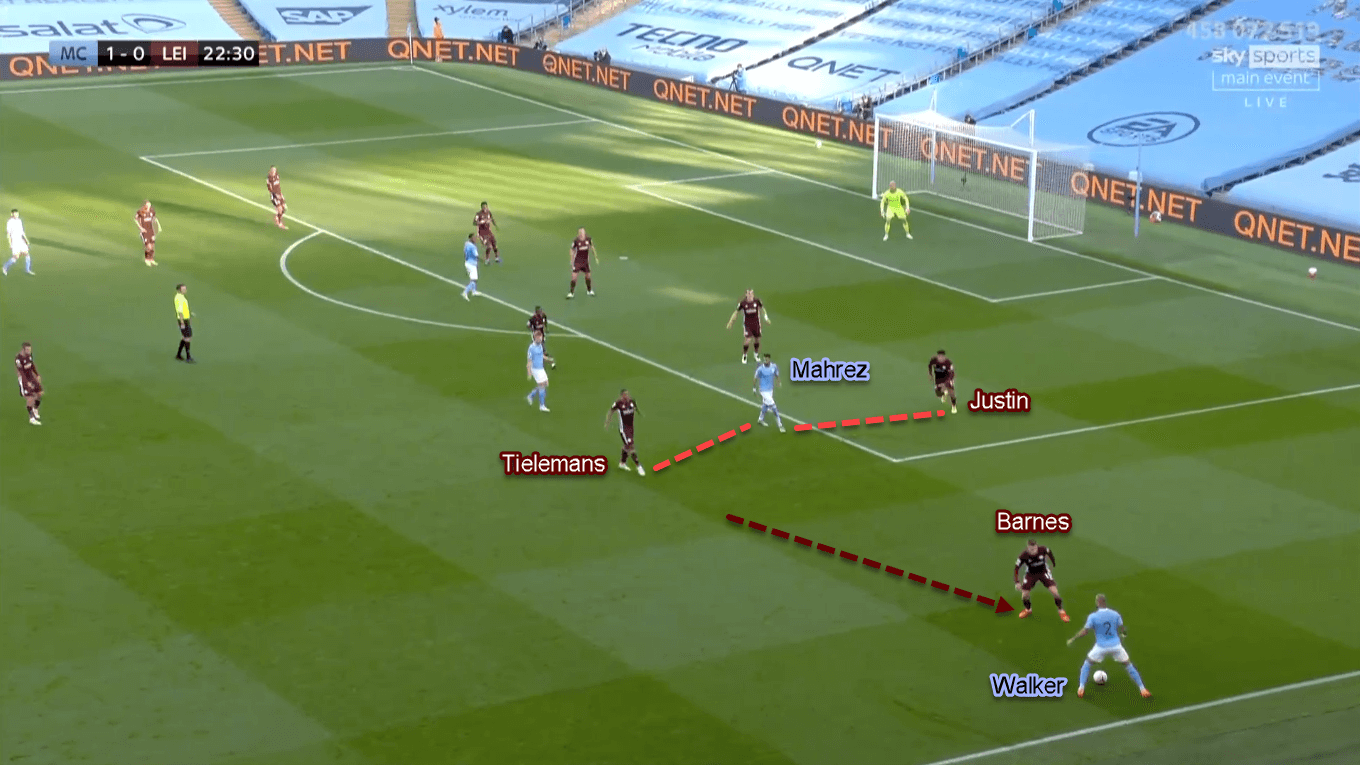
The Foxes hit in transitions
Leicester and counter-attacks: a perfect match made in heaven. This was also the recurring theme in this game, particularly in the first half. But how did they execute that?
Before we get there, we need to examine City’s issues on possession. The first issue was the advanced positioning of Fernandinho. This happened mostly when he drove forward before sending a diagonal pass to Ben Mendy. When he advanced, Fernandinho would leave a gap behind him, namely in City’s right half-space. As the centre-backs had moved to the left in possession, there was virtually no one covering the gap. The fact that Walker was positioned aggressively alongside Mahrez and co. up front didn’t help the Citizens either.
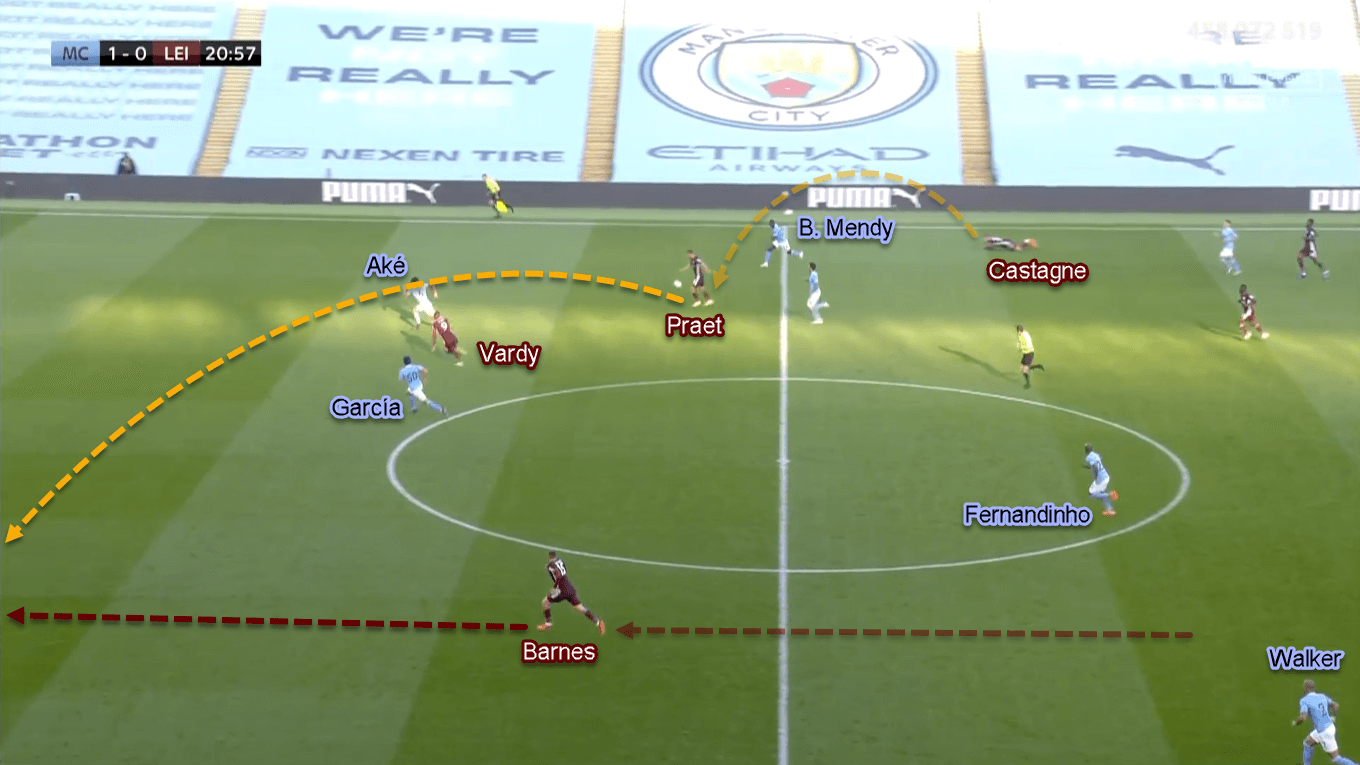
Leicester mainly tried to win the ball on their right flank. That’s because they had the more defensive Dennis Praet as their right-winger compared to Barnes in the opposite side. The numbers even backed this, as Ben Mendy lost the ball nine times – the most among City’s defenders.
When the Foxes won the ball, they would try to find the marauding Barnes in the left half-space. Usually, they would use diagonal balls from Praet or Youri Tielemans to access the winger. However, credit must also go to Vardy for his important role. In Leicester’s counter-attacks, Vardy was tasked to make a run into the right half-space/flank, occupying both City’s centre-backs in the process. This particular movement would further give Barnes more space as García couldn’t let Aké contain Vardy on his own.

City’s failed defensive strategy (part one)
The Citizens’ issues were not only in their attacks but when they didn’t have the ball as well. When City conceded possession, they would try to defend in a more man-oriented manner. This system could be divided into two: the high-press and the mid-block press. Let’s take a look.
In the high-press, City would often allow Kasper Schmeichel to have the ball. But they would close all nearby passing options, particularly the centre-backs and the defensive midfielders. By defending in a man-oriented manner, City focused on engaging in one-versus-one duels, neglecting their structure in the process.
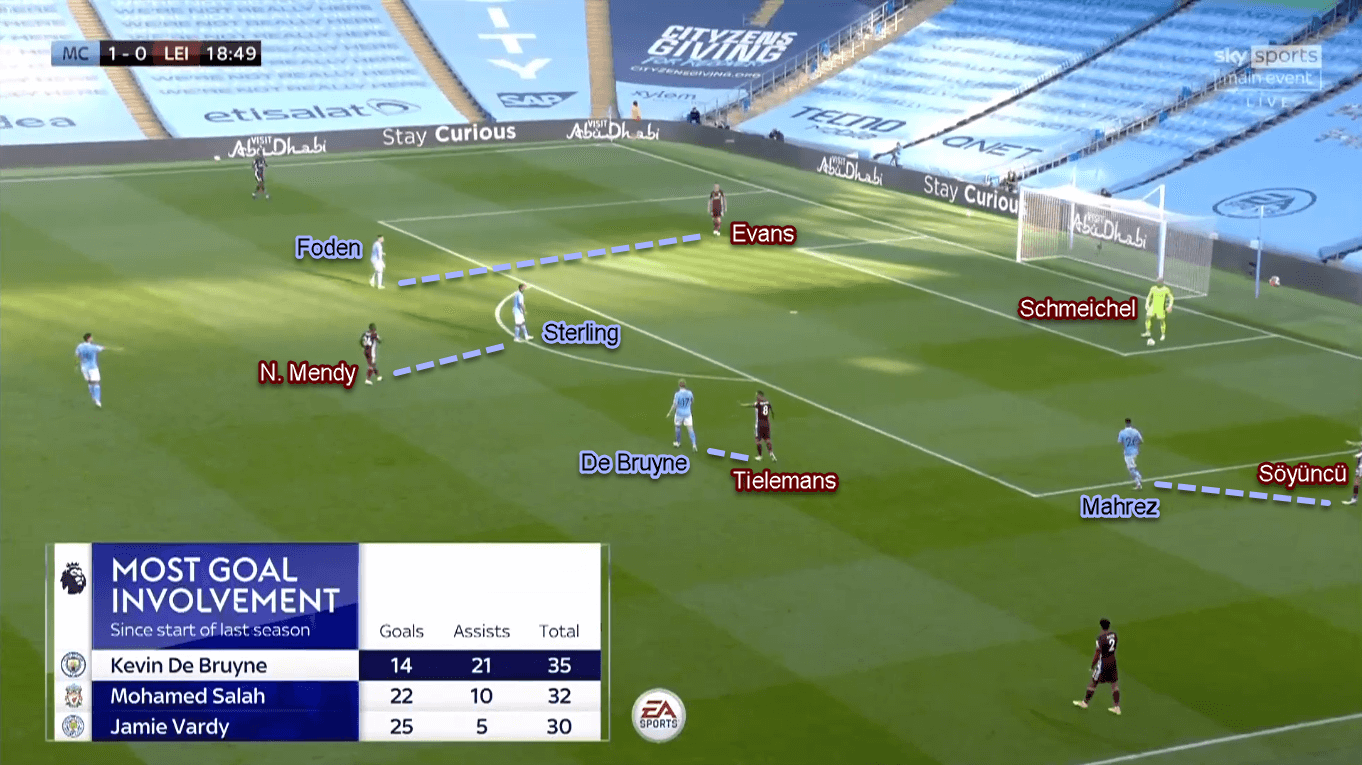
There’s a difference when they defended deeper, though. Instead of defending without any clear structure, City dropped to a 4–4–2 with De Bruyne joining Sterling up front. However, there’s a big issue in this system as there was no compactness (both vertically and horizontally) in the 4–4–2. It means that there were relatively big gaps between City’ players and in between the lines.
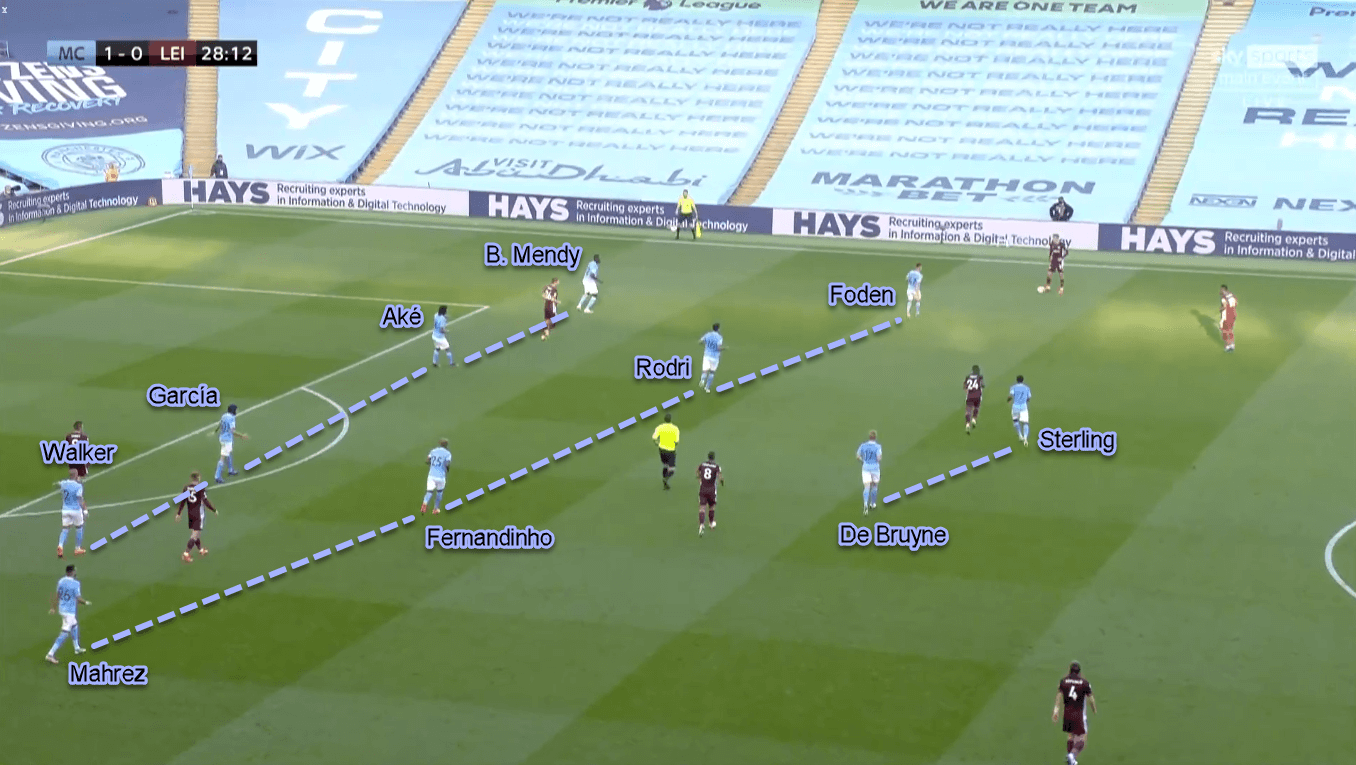
City’s failed defensive strategy (part two)
When defending deeper, City also deployed a man-oriented approach but only to Leicester’s midfielders. It meant that Rodri, Fernandinho, and/or De Bruyne (sometimes together) would press Leicester’s midfielder when the ball was still on its way. The objective was to prevent the Foxes’ midfielder to receive the ball with ease, and further to win the ball back.
However, the lack of compactness made City’s defensive block got exposed from time to time. If one midfielder stepped up, it would only leave one man — mainly Rodri — to protect the huge space. If both midfielders stepped up, Leicester would be allowed ample gap in between the lines. In fact, the Filberts got three goals from exploiting this problem.
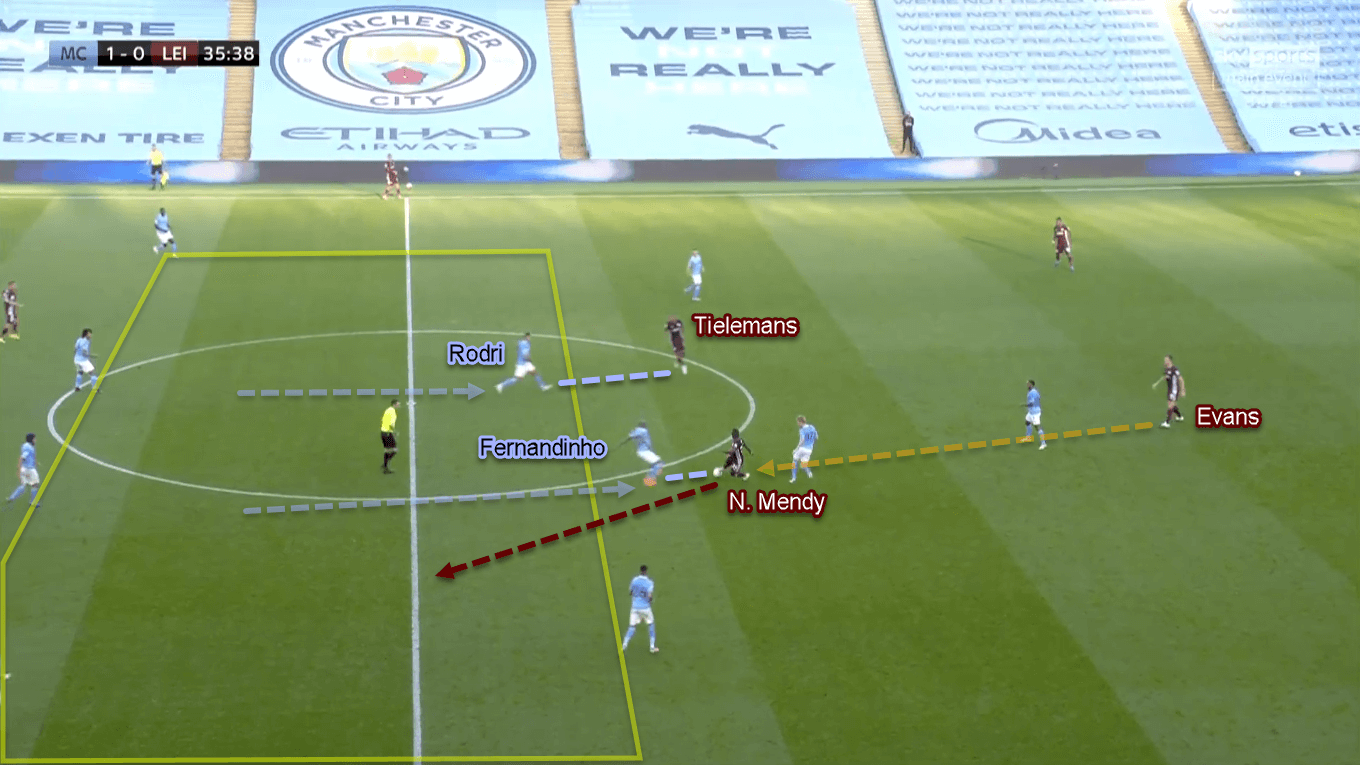
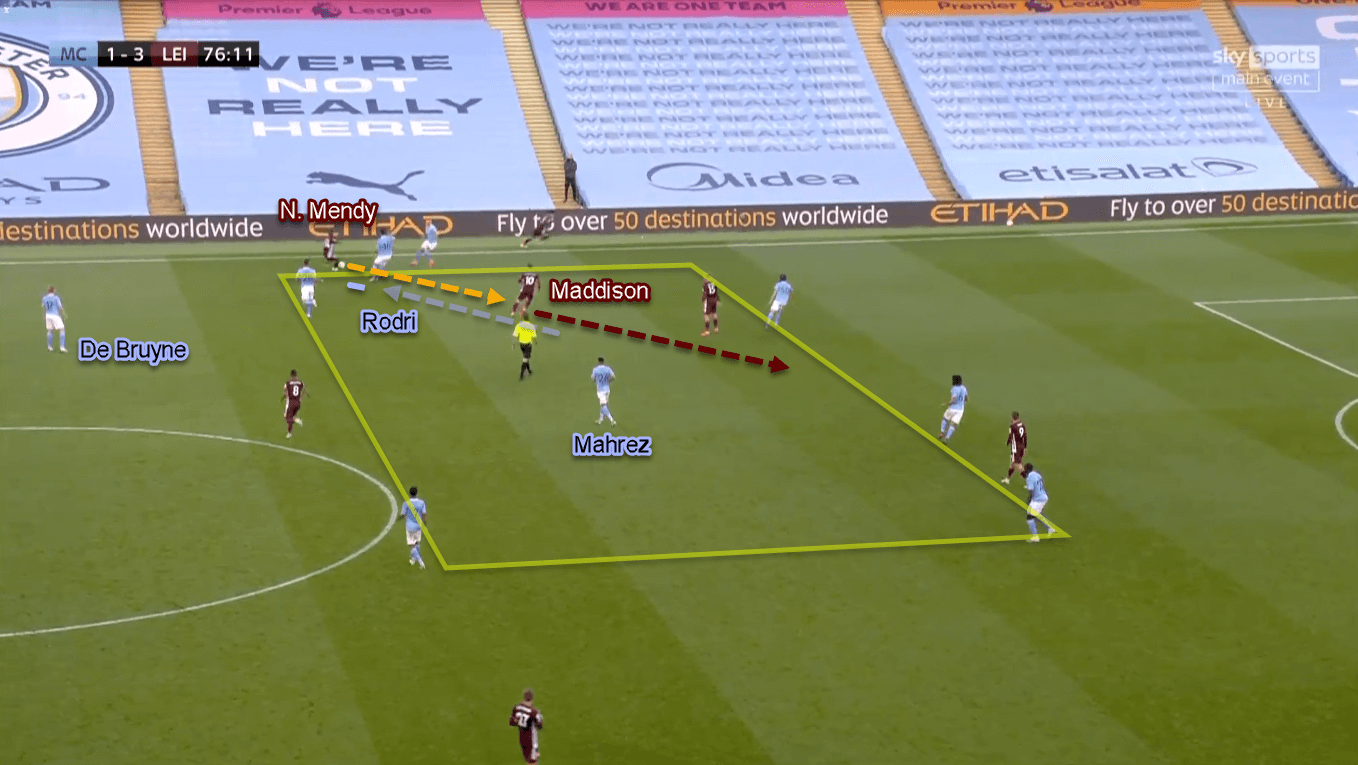

Even worse, the issue could be found in the backline as well. It means that there were relatively big gaps in between City’s defenders that allowed Leicester to play through. Again, the stats showed that all Leicester’s penalties were started by through-balls in between the defenders in blue. Abysmal.

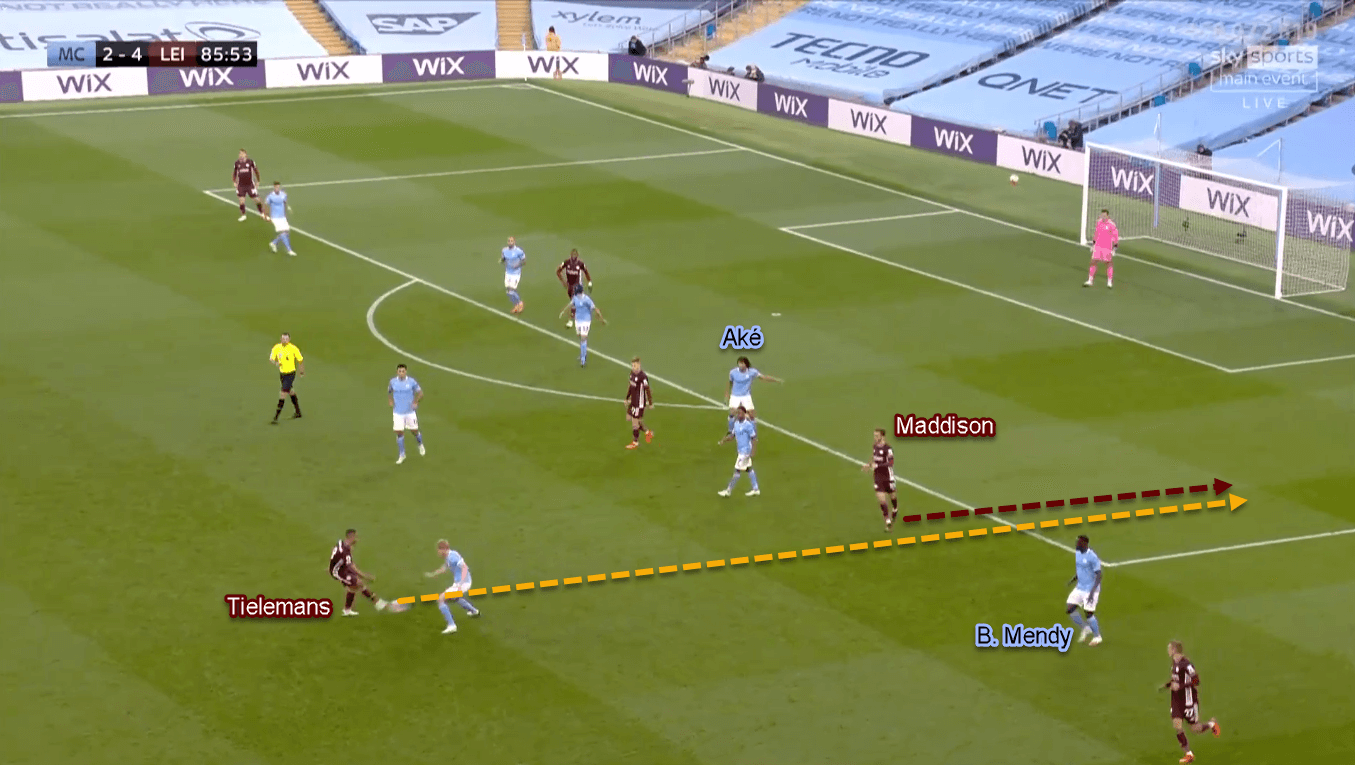
Second-half adjustments
Coming into the second half, both teams didn’t change much in terms of positional structure. City kept their 3–1–6-ish shape, while Leicester stayed in their compact 5–4–1. However, there were some rotations for the home side, especially after Fernandinho got subbed out.
In their ‘new’ shape, Walker didn’t play in the flank anymore. Instead, he tucked inside and play as a makeshift centre-back, similar to Fernandinho. In front of him, De Bruyne shifted a bit to play in the right-side half-space more often. The right-flank then was filled by Torres while Mahrez moved to the position left by De Bruyne. Upfront, Sterling dropped to play as an inverted left-winger after the target man Delap came in.
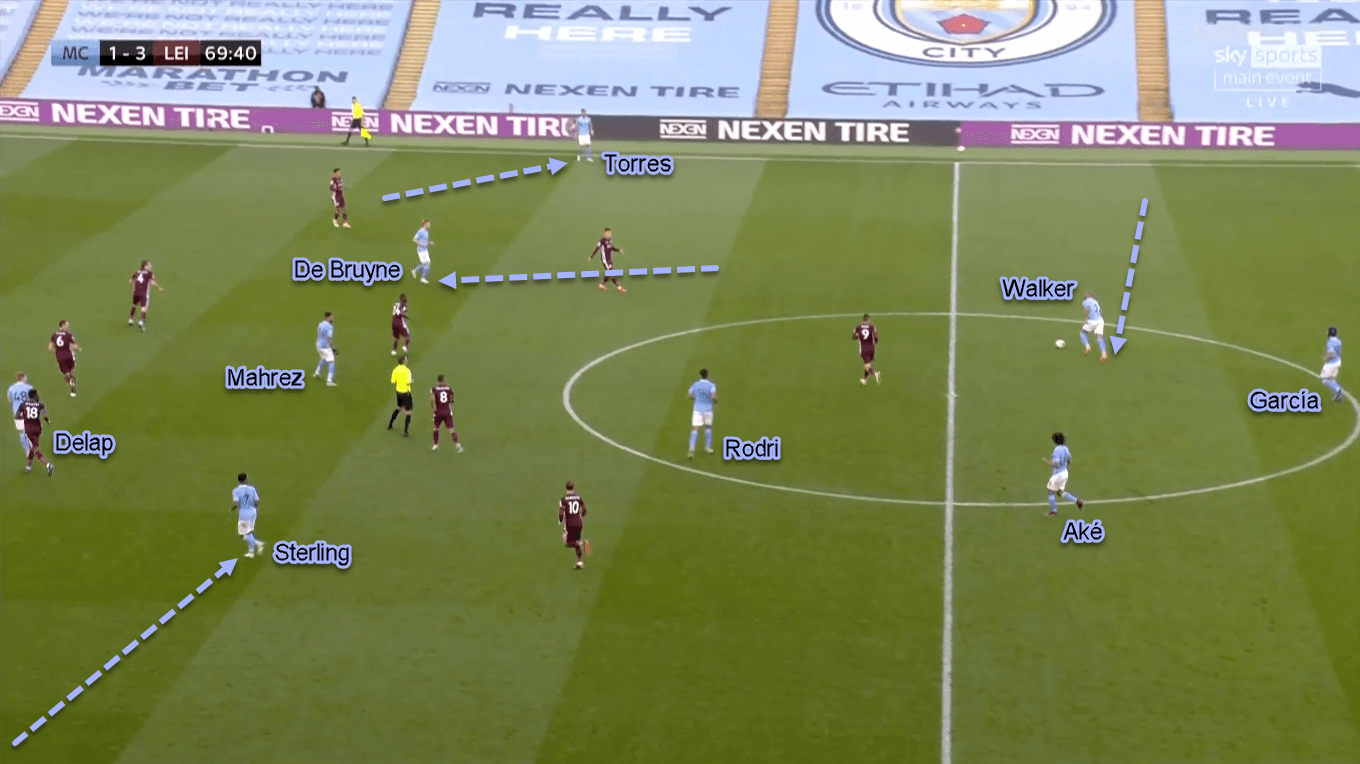
The Citizens varied their approach by sending early crosses in behind as they made at least four of them within 15 minutes after the hour mark. This approach was chosen because it allowed City to attack the box quicker, even before Leicester could organise their backline properly. The statistics showed that City got two chances worthy of 0.32 combined rate in terms of expected goals (xG) using the approach. For comparison, 14 (87.5%) of their remaining shots only combined for 0.77 xG.
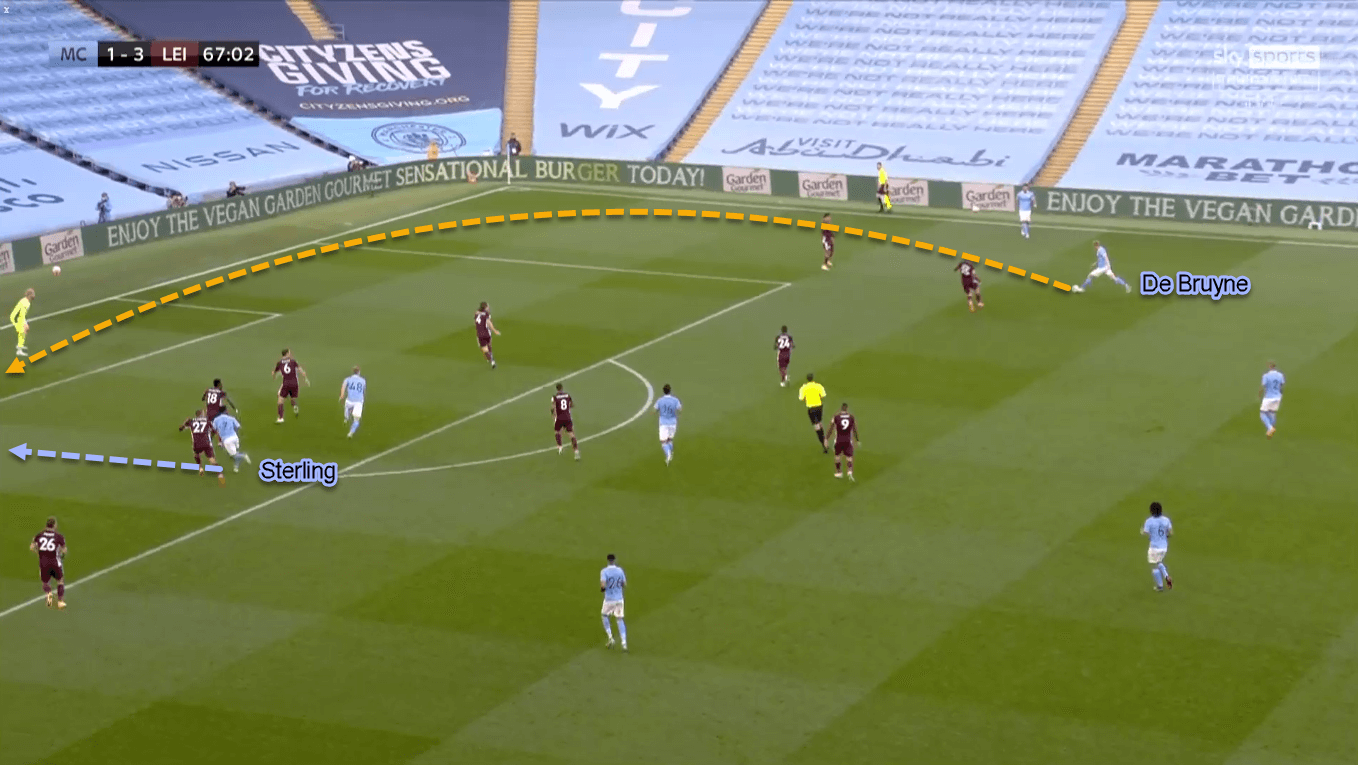
On the opposite side, Leicester used more long balls to bring the ball forward. That happened by choice, not because of City’s high-press. They usually targeted Amartey in the flank due to his height compared to the other right-sided players. The statistics showed that seven (41.17%) of Schmeichel’s long passes were played to the Ghanaian.
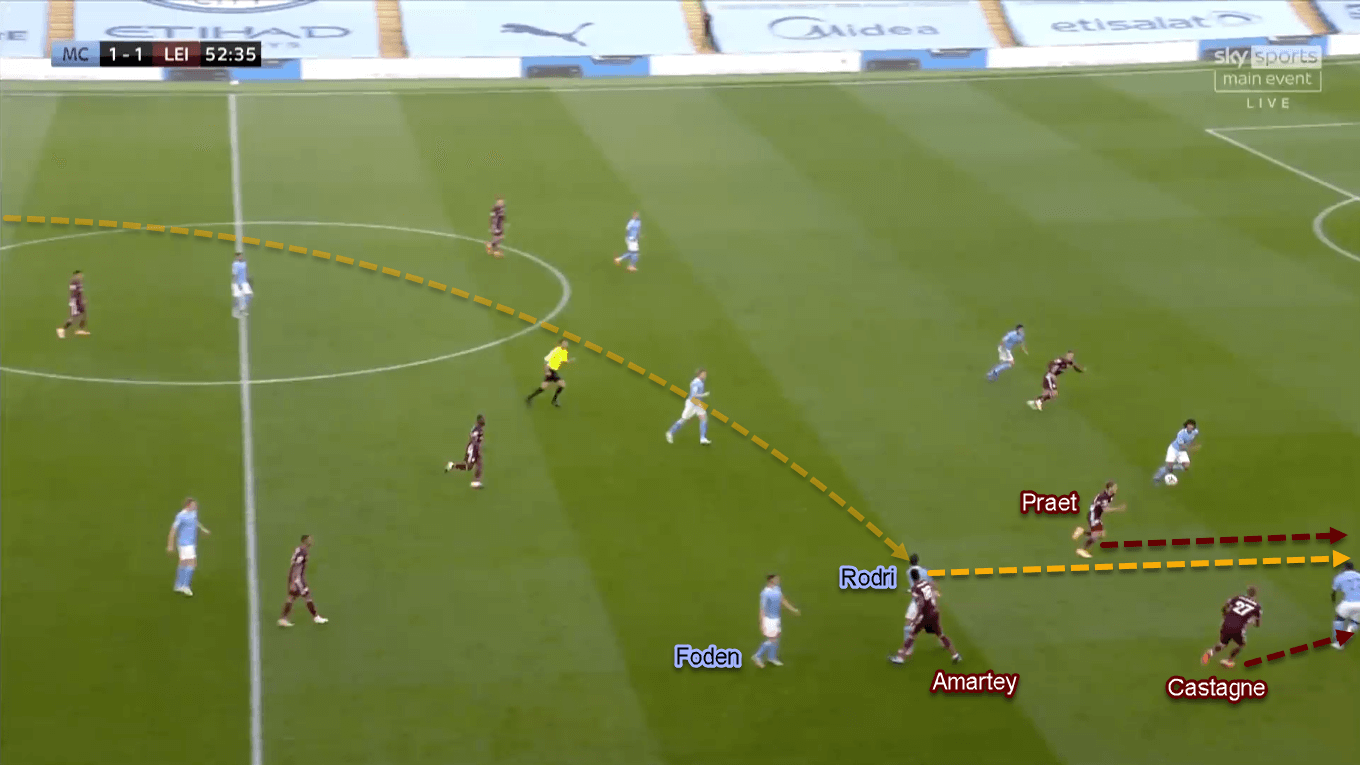
Conclusion
Guardiola had nowhere to hide. His questionable choice of defensive tactics cost City five goals. This was the first time ever that a Guardiola-led team conceded five in a single match. Offensively, there were not many positives either. City were slow on the ball and didn’t have a lot of variation to break Leicester’s defensive block.
Oppositely, full credit must be given to Rodgers and his armada. The incredibly compact 5–4–1 worked brilliantly, yet the Foxes were still superbly clinical in attacks. Leicester are now on top of the league with nine points and 12 goals from three matches. This is their best-ever start for in their Premier League campaign and the question is, can they match their 2015/16 achievement? It’s too early to tell but this is surely a promising sign for the Filberts.
Onto the next one.





Comments